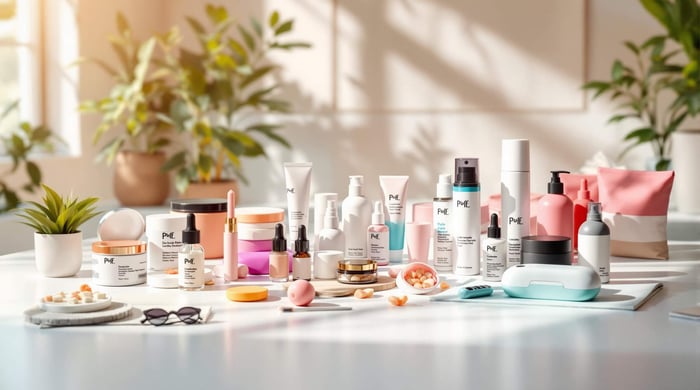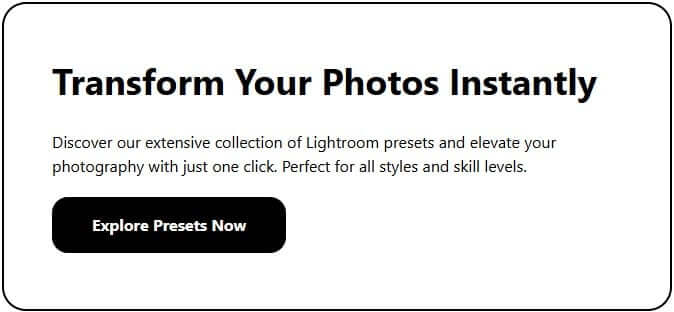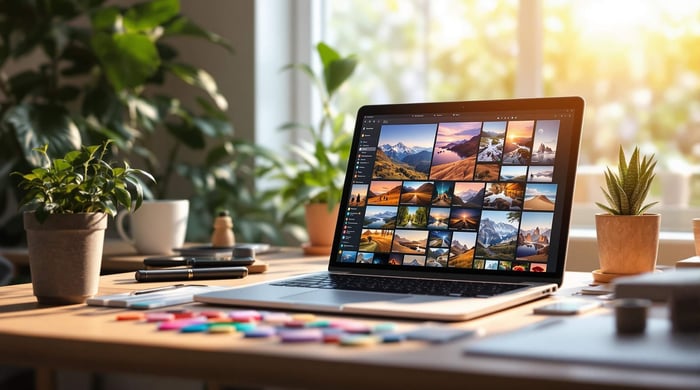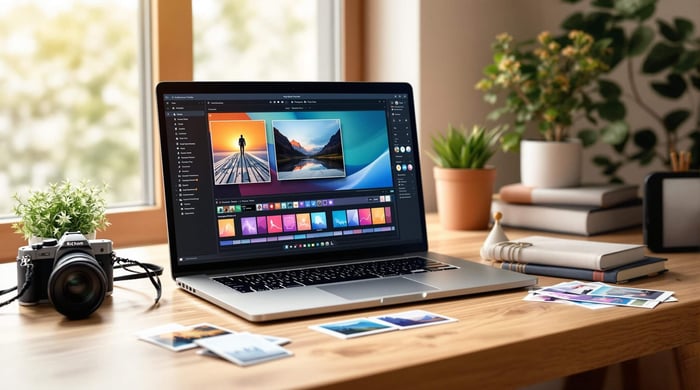Lightroom Presets for Product Photography: Make Your Store Stand Out
Want better product photos that sell more? Lightroom presets can save you time and make your images look professional with just a click. Here’s what they can do:
- Fix lighting and colors for a polished look.
- Highlight product details and textures.
- Create a consistent brand style across all photos.
- Speed up editing with batch processing.
High-quality photos are key for online sales - 75% of shoppers rely on them, and stores with great images see up to 33% better conversions. Using presets can help you achieve this without needing years of photography experience. Whether you’re fixing lighting issues, enhancing details, or creating clean white backgrounds, presets make it simple.
Quick Tip: Start with well-lit photos, use the right preset for your product type, and tweak settings for the perfect result.
Product Photography Enhancement Lightroom Presets and Brushes
Why Use Lightroom Presets for Products
Lightroom presets are a game-changer for product photography in e-commerce. Here's why they can make a big difference for your online store.
Speed Up Your Editing Process
In e-commerce, efficiency is crucial. According to a Shopify study, a streamlined editing workflow can help store owners:
- Group similar photos
- Edit one representative image
- Apply those edits to an entire batch
- Export all images at once
Lightroom's tethering feature even lets you apply presets during the photo shoot itself, cutting down on post-production time entirely [2]. This means you can save hours while maintaining a polished, professional look for your store.
Maintain a Consistent Brand Look
Quick editing goes hand-in-hand with presenting a unified brand identity. Lightroom presets help you ensure every product photo aligns with your brand's visual style.
"Presets are essential for beginners willing to apply edits quickly. On the other hand, professional photographers use this feature to maintain a cohesive look across a batch of images when working on big projects. They also help create a polished portfolio and sustain brand recognition." - mirrorreview.com [3]
You can create your own signature style by fine-tuning:
- Color temperature and tint
- Exposure and contrast
- Shadows and highlights
- Overall mood and tone of the image
Achieve Professional Results as a Beginner
You don’t need years of photography experience to produce professional-looking images. Experts explain:
"A preset is simply an edit that has been 'recorded' so that you can apply the same steps to any image you wish, with just one click of your mouse." - Audrey Ann [4]
To get the most out of presets:
- Start with well-lit, properly exposed photos
- Use presets tailored to product photography
- Make small tweaks to fit each image
- Keep backgrounds clean and distraction-free [1]
Must-Have Product Photography Presets
Getting professional-looking product photos is easier with the right Lightroom presets. These tools can elevate your e-commerce images and save you time.
White Background Presets
A crisp white background is essential for polished product photography. The right presets can remove color tints and create a clean, studio-like finish.
"Presets save a lot of time, you just need to have a properly exposed photo with the right white balance settings." - Veronika K. [5]
The "Soft & Pure White Preset Pack" is a favorite among e-commerce photographers for its ability to:
- Remove unwanted color tints
- Create clean white backgrounds
- Enhance natural product colors
- Retain subtle, natural shadows
To get the most out of white background presets:
- Adjust brightness levels after applying the preset
- Fine-tune highlights to avoid losing details
- Keep some shadows for a sense of depth
If lighting conditions are less than ideal, focus on presets that tweak exposure and contrast to compensate.
Lighting Adjustment Presets
Lighting adjustment presets can rescue photos taken in challenging conditions. These presets correct exposure and contrast while maintaining image quality.
For the best results with lighting presets:
- Start with RAW images for more editing flexibility
- Use spot metering to focus on key product features
- Try bracketing exposures to capture a range of lighting options
"Elevate your product photography with our specially designed Lightroom presets that enhance colors, sharpen details, and create a professional, polished look. These presets adjust exposure, contrast, and saturation to make your products stand out, ensuring they pop with vibrancy and clarity." - Flourish Presets [6]
These adjustments not only improve your workflow but also make your products more visually appealing.
Color Balance Presets
After fixing exposure, accurate color representation is crucial. Color balance presets ensure your products look true to life.
These presets typically adjust:
- White balance
- Saturation levels
- Contrast
- Blue color casts
The "Reduce Blue Cast" preset is especially effective at replacing bluish tones with clean whites [1].
Detail Enhancement Presets
Detail presets are perfect for highlighting textures and fine elements, making your products stand out. They enhance:
- Texture visibility
- Surface details
- Edge sharpness
- Overall clarity
When applying detail enhancement presets, keep these tips in mind:
- Avoid over-sharpening to keep the image natural
- Highlight textures without losing softness
- Balance detail adjustments with overall image quality
- Ensure smooth transitions in highlights
For the best results, apply adjustments in stages - start with white balance and lighting, then move on to color and detail refinements. This step-by-step approach ensures professional, polished product images.
Using Presets in Lightroom
Lightroom presets can make editing product photos quicker and easier. Here's how to use them effectively to improve your product images.
Loading Photos in Lightroom
Start by importing your product photos. Click 'Add Photos' after connecting your camera or card reader. To keep things organized:
- Select 'Copy' when importing from SD cards to save the original files.
- Create a subfolder specifically for your product shots.
- Check 'Don't Import Suspected Duplicates' to avoid clutter.
Choosing the Best Preset
Pick a preset that suits your product type and the conditions of your photo shoot:
- White Products: Use presets that neutralize yellow or gray tones while keeping details intact.
- Textured Items: HDR presets work well to bring out depth, texture, and shape.
- Flat Lay Photography: Opt for presets that boost color, contrast, brightness, and saturation.
If your photos were taken in dim lighting, go for presets that address noise and lighting issues. Once applied, tweak the preset to match your product's specific lighting and color needs.
Adjusting Preset Settings
After applying a preset, fine-tune the settings for the best results:
- Basic Adjustments: Use the Amount slider to control how strong the preset effect is, keeping the image natural.
- Color Refinements: Ensure colors are accurate and remove any unwanted color casts.
- Detail Enhancement: Adjust sharpness and clarity to highlight your product's features without overdoing it.
Once you're happy with the edits, you can speed up the process by applying the same settings to multiple photos.
Editing Multiple Photos
To save time when editing a batch of product photos:
- Edit one photo to your liking.
- Switch to Grid view.
- Copy the edit settings (Photo > Copy Edit Settings).
- Select all the photos you want to edit.
- Paste the settings (Photo > Paste Edit Settings).
Make additional adjustments to individual images if needed for consistency.
Making Your Own Product Presets
Creating custom Lightroom presets can help maintain a consistent look for your brand and save you time during the editing process.
Setting Up Product-Specific Adjustments
Begin by choosing a product photo that best represents your collection to create your preset. Focus on these key adjustments to ensure your photos look polished:
Basic Settings:
- Adjust white balance for accurate colors.
- Tweak exposure and contrast to emphasize product details.
- Modify shadows and highlights to bring out textures.
- Use clarity to make product features stand out.
For instance, when photographing jewelry, increasing brightness and contrast can make the piece sparkle. Use tools like masks to fine-tune specific areas without affecting the entire image. The Spot Healing tool can also help remove distracting elements like dust or imperfections.
"Applying a Lightroom preset is often just a good starting point in the editing process. Often you'll need to tweak the preset to suit the lighting and colors in a photo, rather than getting the exact look you want with just the click of a button." - Jane Allan, Professional Portrait Photographer and Founder of The Lens Lounge [7]
When saving your preset, leave out the following:
- Local brush adjustments
- Spot removal edits
- Specific crop settings
Once you've fine-tuned and saved your product-specific preset, the next step is to organize and manage it effectively.
Managing Custom Presets
Organize Your Presets:
- Group presets by product type for easy access.
- Use clear, descriptive names that reflect each preset's purpose.
- Add symbols like "@" or "*" to prioritize frequently used presets.
- Place your most-used presets in the "Favorites" folder for quick selection.
Keeping your preset library organized not only speeds up your workflow but also helps maintain a consistent visual style for your brand.
Before making changes to your presets, follow these steps:
- Back up your current presets to avoid losing any work.
- Remove presets that are outdated or no longer needed.
- Organize presets directly in Lightroom, rather than in your computer's file system.
Lightroom uses a single folder structure, so keep things simple and intuitive. You can also delete default Lightroom presets you never use to reduce clutter, making it easier to focus on your custom options.
To ensure consistent branding, define clear editing standards. These might include:
- Preferred color tones
- Lighting guidelines
- Background styles
- Overall visual goals
Main Takeaways
Lightroom presets can make a big difference in improving product photography. High-quality, well-edited photos not only boost sales but also enhance how customers perceive your brand. With presets, you can create professional edits while maintaining a consistent look throughout your product catalog.
Why use Lightroom presets? Here are the main benefits:
- They save time with ready-to-use settings.
- They help maintain a consistent visual style.
- They quickly improve the overall quality of your images. [8]
Using these tools can help streamline your editing process and improve your workflow.
How to Start Using Presets
Ready to give Lightroom presets a try? Here’s how to get started:
Before diving into advanced edits, focus on mastering the basics of Lightroom presets. Start with a small collection of presets that align with your brand's style.
Tips for success:
- Document your preset settings to ensure consistency.
- Always back up your original images before editing.
- Test your presets on different product types to find the best fit.



.png)




